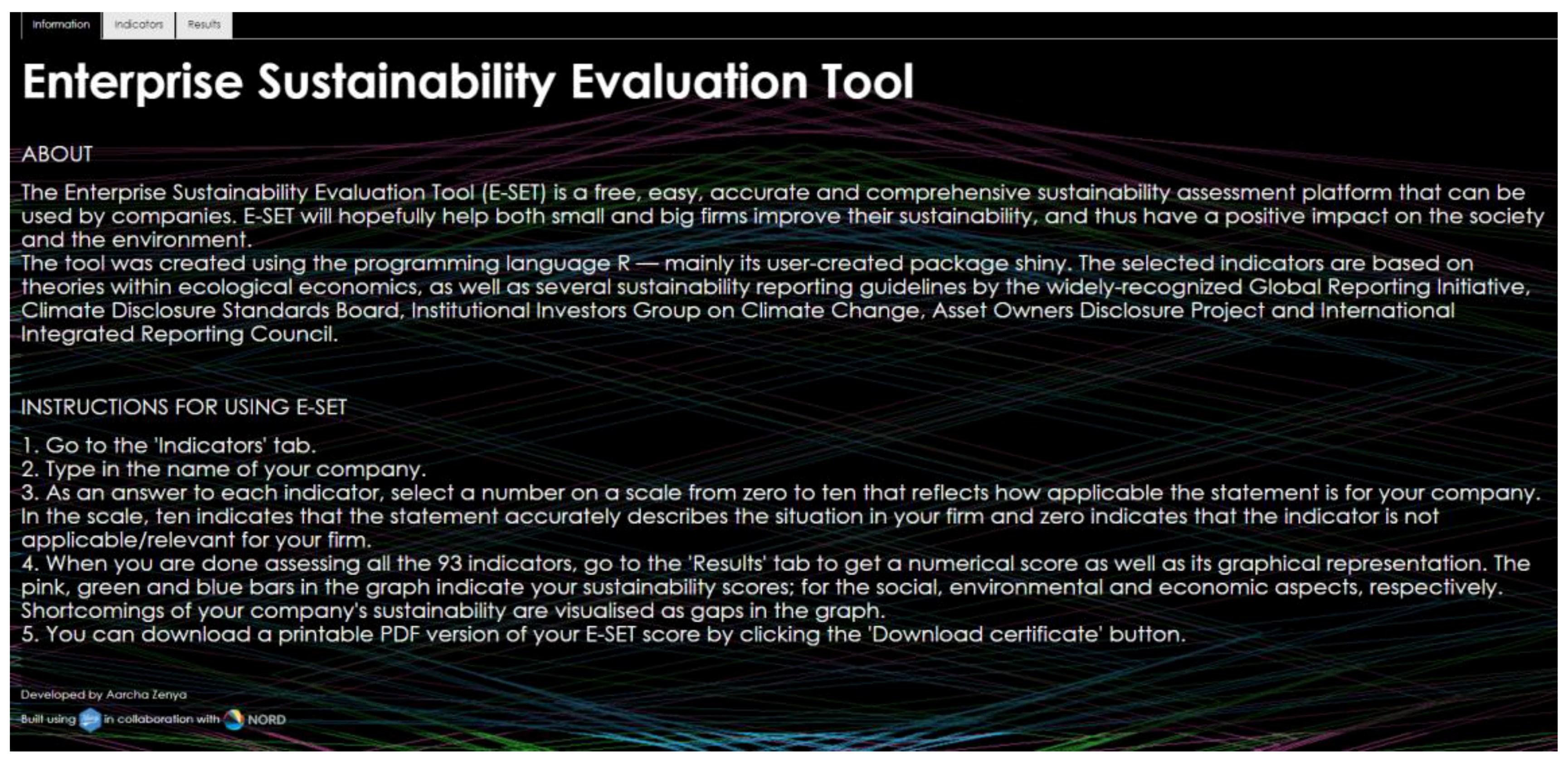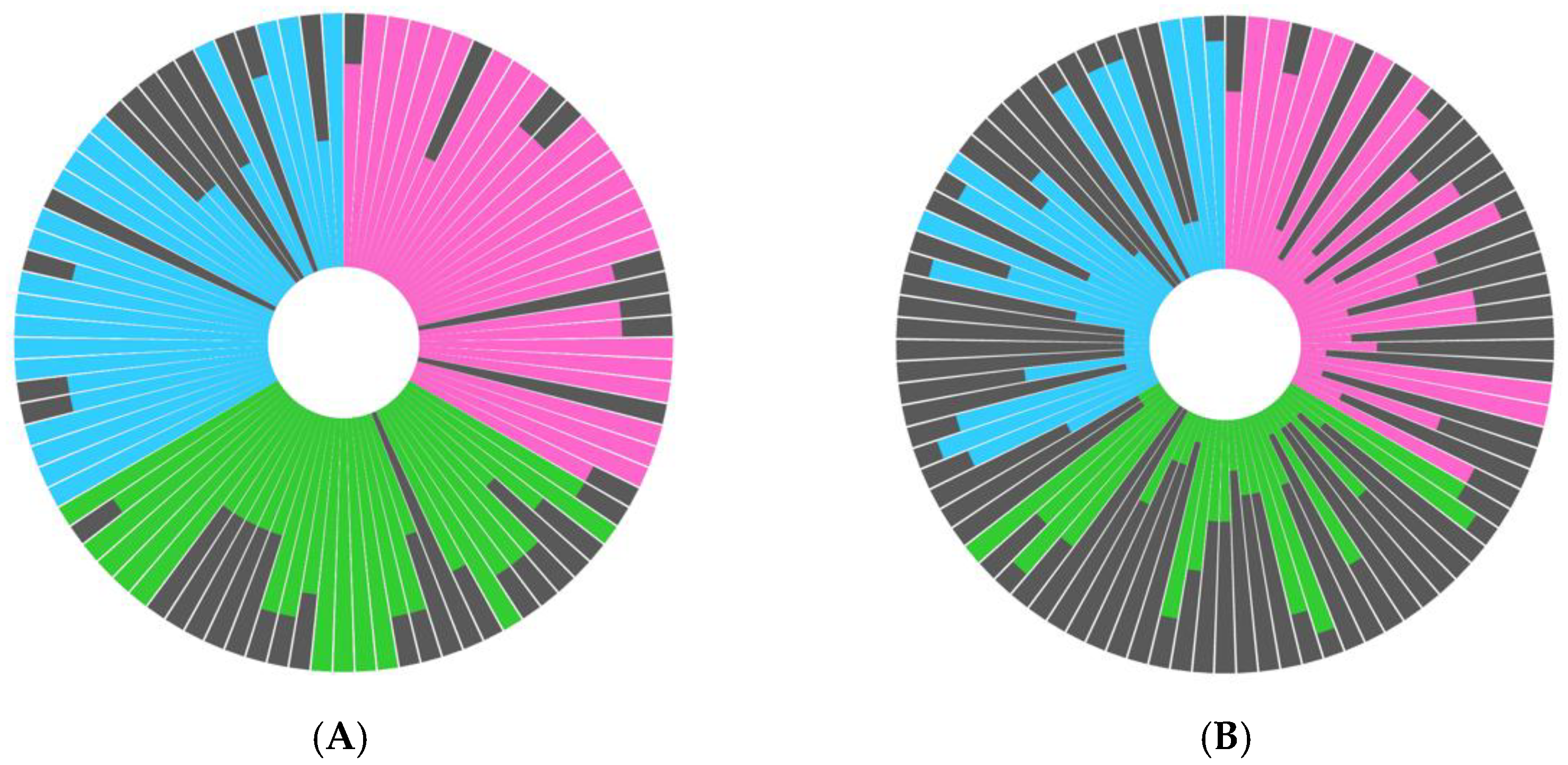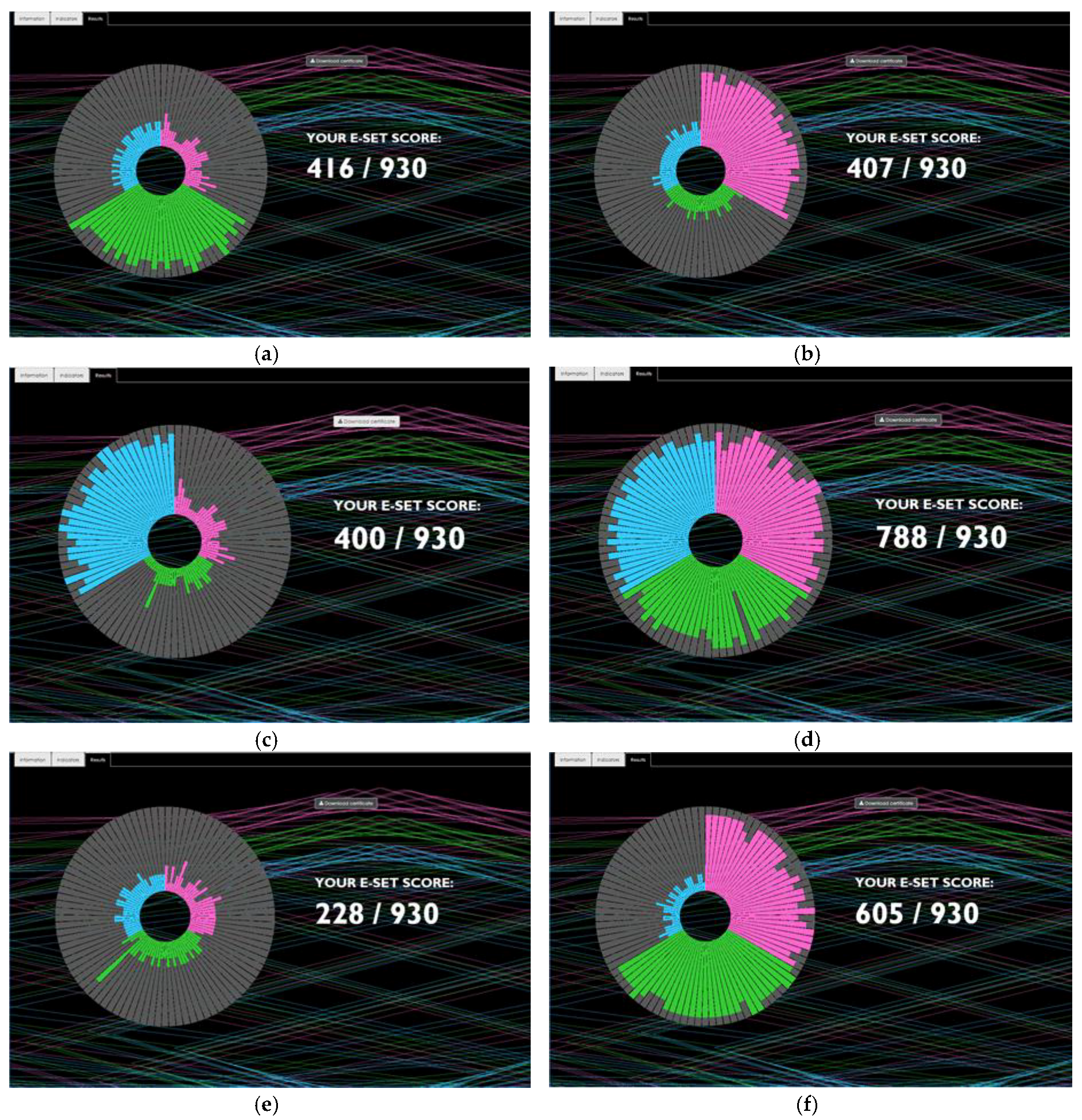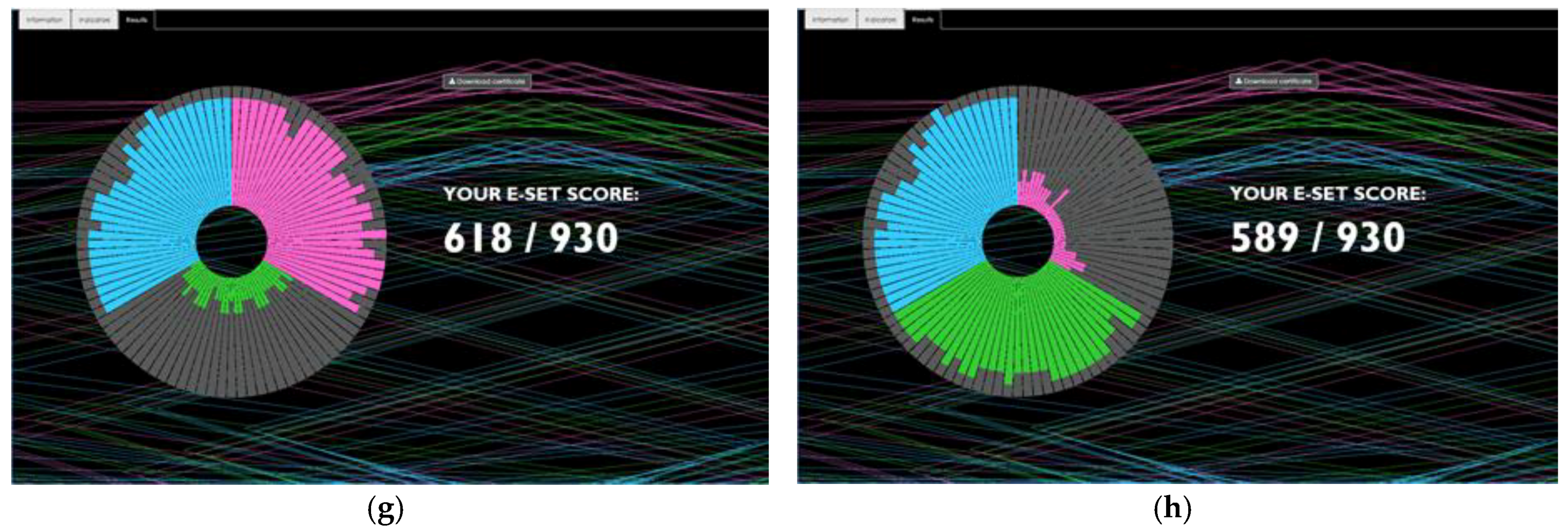Assessing Corporate Sustainability with the Enterprise Sustainability Evaluation Tool (E-SET)
Abstract
1. Introduction
2. Methods
- The Climate Change Reporting Framework by the Climate Disclosure Standards Board
- The G4 Sustainability Reporting Guidelines by the Global Reporting Initiative (GRI)
- The Investor Expectations reports by the Institutional Investors Group on Climate Change
- The Global Climate Change Risk Survey reports by the Asset Owners Disclosure Project
- The International Integrated Reporting Framework by the International Integrated Reporting Council
3. Results
4. Discussion
4.1. Abiding by the Bellagio Principles
4.2. Connecting the Indicators with Sustainability-Related Concepts
4.3. Using E-SET in Different Sectors
4.4. Limitations of E-SET
4.5. Positive Effects by Using E-SET
5. Conclusions
Author Contributions
Funding
Acknowledgments
Conflicts of Interest
References
- Brundtland, G.H.; Khalid, M.; Agnelli, S.; Al-Athel, S.A.; Casanova, P.G.; Chidzero, B.T.G.; Padika, L.M.; Hauff, V.; Lang, I.; Shijun, M.; et al. Our Common Future; World Commission on Environment and Development: Geneva, Switzerland, 1987; p. 300. [Google Scholar]
- Costanza, R.; Cumberland, J.H.; Daly, H.; Goodland, R.; Norgaard, R.B.; Kubiszewski, I.; Franco, C. An Introduction to Ecological Economics; CRC Press: Boca Raton, FL, USA, 2014. [Google Scholar]
- Montiel, I.; Delgado-Ceballos, J. Defining and measuring corporate sustainability: Are we there yet? Organ. Environ. 2014, 27, 113–139. [Google Scholar] [CrossRef]
- Lankoski, L. Cost and revenue impacts of corporate responsibility: Comparisons across sustainability dimensions and product chain stages. Scand. J. Manag. 2009, 25, 57–67. [Google Scholar] [CrossRef]
- Marshall, J.D.; Toffel, M.W. Framing the elusive concept of sustainability: A sustainability hierarchy. Environ. Sci. Technol. 2005, 39, 673–682. [Google Scholar] [CrossRef] [PubMed]
- Villeneuve, C.; Tremblay, D.; Riffon, O.; Lanmafankpotin, G.; Bouchard, S. A Systemic tool and process for sustainability assessment. Sustainability 2017, 9, 1909. [Google Scholar] [CrossRef]
- Ness, B.; Urbel-Piirsalu, E.; Anderberg, S.; Olsson, L. Categorising tools for sustainability assessment. Ecol. Econ. 2007, 60, 498–508. [Google Scholar] [CrossRef]
- Büyüközkan, G.; Karabulut, Y. Sustainability performance evaluation: Literature review and future directions. J. Environ. Manag. 2018, 217, 253–267. [Google Scholar] [CrossRef] [PubMed]
- Miller, K.; Serafeim, G. Chief Sustainability Officers: Who are They and What do They do? Harvard Business School: Boston, MA, USA, 2014. [Google Scholar]
- Bloomberg, L.P. Company Overview of Sustainalytics B.V. Available online: https://www.bloomberg.com/research/stocks/private/snapshot.asp?privcapid=47018641 (accessed on 7 January 2018).
- Valenti, W.C.; Kimpara, J.M.; Preto, B.D.L.; Moraes-Valenti, P. Indicators of sustainability to assess aquaculture systems. Ecol. Indic. 2018, 88, 402–413. [Google Scholar] [CrossRef]
- Naganathan, H.; Chong, W.K. Evaluation of state sustainable transportation performances (SSTP) using sustainable indicators. Sustain. Cities Soc. 2017, 35, 799–815. [Google Scholar] [CrossRef]
- Mapar, M.; Jafari, M.J.; Mansouri, N.; Arjmandi, R.; Azizinejad, R.; Ramos, T.B. Sustainability indicators for municipalities of megacities: Integrating health, safety and environmental performance. Ecol. Indic. 2017, 83, 271–291. [Google Scholar] [CrossRef]
- Escribano, M.; Díaz-Caro, C.; Mesias, F.J. A participative approach to develop sustainability indicators for dehesa agroforestry farms. Sci. Total. Environ. 2018, 640–641, 89–97. [Google Scholar] [CrossRef] [PubMed]
- Elhuni, R.M.; Ahmad, M.M. Key performance indicators for sustainable production evaluation in oil and gas sector. Procedia Manuf. 2017, 11, 718–724. [Google Scholar] [CrossRef]
- Chen, H.-S. The Establishment and Application of Environment Sustainability Evaluation Indicators for Ecotourism Environments. Sustainability 2015, 7, 4727–4746. [Google Scholar] [CrossRef]
- Sacramento Rivero, J.; Eastmond-Spencer, A.; Becerril García, J.; Navarro-Pineda, F. A three-dimensional sustainability evaluation of jatropha plantations in Yucatan, Mexico. Sustainability 2016, 8, 1316. [Google Scholar] [CrossRef]
- Sala, S.; Ciuffo, B.; Nijkamp, P. A systemic framework for sustainability assessment. Ecol. Econ. 2015, 119, 314–325. [Google Scholar] [CrossRef]
- Epstein, M.J. Making Sustainability Work: Best Practices in Managing and Measuring Corporate Social, Environmental and Economic Impacts; Routledge: Sheffield, UK, 2018. [Google Scholar]
- Kasanen, E.; Lukka, K.; Siitonen, A. The constructive approach in management accounting research. J. Manag. Account. Res. 1993, 5, 243. [Google Scholar]
- Oyegoke, A. The constructive research approach in project management research. Int. J. Manag. Proj. Bus. 2011, 4, 573–595. [Google Scholar] [CrossRef]
- Task Force on Climate-related Financial Disclosures. Phase I Report of the Task Force on Climate-Related Financial Disclosures; Financial Stability Board: Basel, Switzerland, 2016; p. 64. [Google Scholar]
- Baumgartner, R.J.; Ebner, D. Corporate sustainability strategies: Sustainability profiles and maturity levels. Sustain. Dev. 2010, 18, 76–89. [Google Scholar] [CrossRef]
- Medel-González, F.; García-Ávila, L.; Acosta-Beltrán, A.; Hernández, C. Measuring and evaluating business sustainability: Development and application of corporate index of sustainability performance. In Sustainability Appraisal: Quantitative Methods and Mathematical Techniques for Environmental Performance Evaluation; Erechtchoukova, M.G., Khaiter, P.A., Golinska, P., Eds.; Springer: Berlin/Heidelberg, Germany, 2013; pp. 33–61. [Google Scholar]
- Sharifi, A.; Murayama, A. A critical review of seven selected neighborhood sustainability assessment tools. Environ. Impact Assess. Rev. 2013, 38, 73–87. [Google Scholar] [CrossRef]
- Saaty, T.L. The ANP for Decision Making with Dependence and Feedback; RWS Publications: Pittsburgh, PA, USA, 1996. [Google Scholar]
- Wind, Y.; Saaty, T.L. Marketing Applications of the Analytic Hierarchy Process. Manag. Sci. 1980, 26, 641–658. [Google Scholar] [CrossRef]
- Singh, R.K.; Murty, H.R.; Gupta, S.K.; Dikshit, A.K. An overview of sustainability assessment methodologies. Ecol. Indic. 2009, 9, 189–212. [Google Scholar] [CrossRef]
- Munda, G. “Measuring sustainability”: A multi-criterion framework. Environ. Dev. Sustain. 2005, 7, 117–134. [Google Scholar] [CrossRef]
- Pope, J.; Annandale, D.; Morrison-Saunders, A. Conceptualising sustainability assessment. Environ. Impact Assess. Rev. 2004, 24, 595–616. [Google Scholar] [CrossRef]
- Resnizky, H.G. Learning Shiny; Packt Publishing Ltd.: Birmingham, UK, 2015; p. 246. [Google Scholar]
- Wickham, H. ggplot2: Elegant Graphics for Data Analysis; Springer: Houston, TX, USA, 2016; p. 260. [Google Scholar]
- Hardi, P.; Zdan, T. Principles in Practice; Main entry under title: Assessing sustainable development; International Institute for Sustainable Development: Winnipeg, MB, Canada, 1997. [Google Scholar]
- Kuhlman, T.; Farrington, J. What is sustainability? Sustainability 2010, 2, 3436–3448. [Google Scholar] [CrossRef]
- Tracey, S.; Anne, B. OECD Insights Sustainable Development Linking Economy, Society, Environment: Linking Economy, Society, Environment; OECD Publishing: Paris, France, 2008. [Google Scholar]
- Espeland, W.N.; Stevens, M.L. A Sociology of quantification. Eur. J. Sociol. 2008, 49, 401–436. [Google Scholar] [CrossRef]
- Becker, J. Making sustainable development evaluations work. Sustain. Dev. 2004, 12, 200–211. [Google Scholar] [CrossRef]
- Avery, G. Leadership for Sustainable Futures: Achieving Success in a Competitive World; Edward Elgar Publishing: Cheltenham, UK, 2005. [Google Scholar]
- Bloxham, E. Economic Value Management: Applications and Techniques; Wiley: Hoboken, NJ, USA, 2003; Volume 161. [Google Scholar]
- Montiel, I. Corporate social responsibility and corporate sustainability: Separate pasts, common futures. Organ. Environ. 2008, 21, 245–269. [Google Scholar] [CrossRef]
- Carroll, A.B. A three-dimensional conceptual model of corporate performance. Acad. Manag. Rev. 1979, 4, 497–505. [Google Scholar] [CrossRef]
- Shrivastava, P.; Addas, A. The impact of corporate governance on sustainability performance. J. Sustain. Financ. Invest. 2014, 4, 21–37. [Google Scholar] [CrossRef]
- Valente, M. Theorizing firm adoption of sustaincentrism. Organ. Stud. 2012, 33, 563–591. [Google Scholar] [CrossRef]
- Kantabutra, S. Measuring corporate sustainability: A Thai approach. Meas. Bus. Excel. 2014, 18, 73–88. [Google Scholar] [CrossRef]
- Rothaermel, F.T. Competitive advantage, firm performance and business models. In Strategic Management, 3rd ed.; McGraw-Hill Education: New York, NY, USA, 2017; pp. 140–171. [Google Scholar]
- Mayer, F.S.; Frantz, C.M. The connectedness to nature scale: A measure of individuals’ feeling in community with nature. J. Environ. Psychol. 2004, 24, 503–515. [Google Scholar] [CrossRef]
- Lubin, D.A.; Esty, D.C. The sustainability imperative. Harv. Bus. Rev. 2010, 88, 42–50. [Google Scholar]
- Clark, G.L.; Feiner, A.; Viehs, M. From the stockholder to the stakeholder: How sustainability can drive financial outperformance. SSRN Electron. J. 2014, 66. [Google Scholar] [CrossRef]
- Nidumolu, R.; Prahalad, C.K.; Rangaswami, M.R. Why sustainability is now the key driver of innovation. Harv. Bus. Rev. 2009, 87, 56–64. [Google Scholar]
- Borchardt, M.; Wendt, M.H.; Pereira, G.M.; Sellitto, M.A. Redesign of a component based on ecodesign practices: Environmental impact and cost reduction achievements. J. Clean. Prod. 2011, 19, 49–57. [Google Scholar] [CrossRef]
- Cortina, H. These five companies are leading the charge on recycling. Forbes. 20 April 2018. Available online: https://www.forbes.com/sites/justcapital/2018/04/20/these-5-companies-are-leading-the-charge-on-recycling/ (accessed on 3 December 2018).
- World Economic Forum. Responsible Investment in Fragile Contexts; World Economic Forum: Cologny, Switzerland, 2016; p. 28. [Google Scholar]
- York, J.; Dembek, C.; Potter, B. Sustainability Reporting to Improve Organizational Performance; Ivey Business School: London, ON, Canada, 2017; p. 55. [Google Scholar]
- Engida, T.G.; Rao, X.; Berentsen, P.B.M.; Oude Lansink, A.G.J.M. Measuring corporate sustainability performance—The case of European food and beverage companies. J. Clean. Prod. 2018, 195, 734–743. [Google Scholar] [CrossRef]
- Gasparatos, A. Embedded value systems in sustainability assessment tools and their implications. J. Environ. Manag. 2010, 91, 1613–1622. [Google Scholar] [CrossRef]
- Sadovska, V. Corporate Sustainability Standards—A Comparison of Two Sustainability Indices. Master’s Thesis, Swedish University of Agricultural Sciences, Uppsala, Sweden, 2016. [Google Scholar]
- Virtanen, T.; Tuomaala, M.; Pentti, E. Energy efficiency complexities: A technical and managerial investigation. Manag. Account. Res. 2013, 24, 401–416. [Google Scholar] [CrossRef]
- Matten, D.; Moon, J. “Implicit” and “explicit” CSR: A conceptual framework for a comparative understanding of corporate social responsibility. Acad. Manag. Rev. 2008, 33, 404–424. [Google Scholar] [CrossRef]
- Powell, W.W.; DiMaggio, P.J. The iron cage revisited institutional isomorphism and collective rationality in organizational fields. In Economics Meets Sociology in Strategic Management; Emerald Group Publishing Limited: Bingley, UK, 2000; pp. 143–166. [Google Scholar]
- Parguel, B.; Benoît-Moreau, F.; Larceneux, F. How sustainability ratings might deter ‘greenwashing’: A closer look at ethical corporate communication. J. Bus. Ethics 2011, 102, 15. [Google Scholar] [CrossRef]





| Environment | Society | Economy |
|---|---|---|
| Eco-friendliness of products, packaging etc. | Health and safety of employees and customers, including consumer privacy and data protection | Investments on research and development and on the local community, and assessment of investments |
| Waste and recycling | Positive impacts on the local community | Long term business strategy and assessment of current and future economic losses |
| Energy use and saving methods | Ethics, corruption, and human rights | Equal pay |
| Impacts on biodiversity and habitats | Employee training and benefits | Fair competition and long-term profits, including but not limited to income from after sales services |
| Greenhouse gas emissions | Diversity and discrimination | The triple bottom line |
| Transportation-related environmental impacts | Planning for positive social impacts | Process improvement and cost reduction |
| Value chain’s impacts on the environment | Value chain’s societal impacts | Value chain’s economic position |
| Environmental concerns of the stakeholder | Societal concerns of the stakeholder | Economic concerns of the stakeholder |
| Internal awareness on environmental issues | Internal awareness on societal issues | Internal awareness on economic issues |
© 2018 by the authors. Licensee MDPI, Basel, Switzerland. This article is an open access article distributed under the terms and conditions of the Creative Commons Attribution (CC BY) license (http://creativecommons.org/licenses/by/4.0/).
Share and Cite
Zenya, A.; Nystad, Ø. Assessing Corporate Sustainability with the Enterprise Sustainability Evaluation Tool (E-SET). Sustainability 2018, 10, 4661. https://doi.org/10.3390/su10124661
Zenya A, Nystad Ø. Assessing Corporate Sustainability with the Enterprise Sustainability Evaluation Tool (E-SET). Sustainability. 2018; 10(12):4661. https://doi.org/10.3390/su10124661
Chicago/Turabian StyleZenya, Aarcha, and Øystein Nystad. 2018. "Assessing Corporate Sustainability with the Enterprise Sustainability Evaluation Tool (E-SET)" Sustainability 10, no. 12: 4661. https://doi.org/10.3390/su10124661
APA StyleZenya, A., & Nystad, Ø. (2018). Assessing Corporate Sustainability with the Enterprise Sustainability Evaluation Tool (E-SET). Sustainability, 10(12), 4661. https://doi.org/10.3390/su10124661




